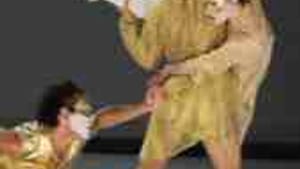Stay in the Loop
BSR publishes on a weekly schedule, with an email newsletter every Wednesday and Thursday morning. There’s no paywall, and subscribing is always free.
Night of the dense metaphors
BalletX Summer Series (2nd review)

Biologists and computer scientists alike employ a value-neutral conception that describes viruses as a type of information. These organisms approach new territory, anchor themselves to another life form and transmit a code that then programs the host to replicate that information again and again. Cells may or may not resist this process.
In A Soliloquy Among Many, the choreographer Roger C. Jeffrey takes this concept as metaphor to show the converse: That information can transform communities as it spreads virally. He weaves this idea around the Promethean story of an outsider (Chloe Horne) who is segregated from society by the force of her voice.
The fashion designer Loris Diran wound Horne's body in white helical stripes, a stark contrast to the brown, full-body-length dresses and pants worn by the other dancers. In appearance and movement, Horne represents the individual— something dangerous to a tribe, because she could infect them with her ideas.
As the women dance in a ritual series of patterns, both genders thrust Horne away or throw her to the ground. The entire group forms a barricade of bodies against Horne's every attempt at integration. In one of Soliloquy's most powerful moments, the tide of humanity repels her advances and her face caves into desperate dejection.
Crowd vs. individual
But slowly, she begins to infect them. Here, Jeffrey's metaphor resolves and gains power. As Horne finds opportunity to dance with isolated members of the mob— including a powerful duet with Barry Kerollis— the group slowly sheds its attire to reveal the proud, bold stripes that match Horne's appearance. What springs the transformation— man's desire for the outsider? Pure lust?— remains unclear and doesn't matter; what matters is Jeffrey's metaphor of crowd-vs.-individual.
Few Prometheus stories (David Mamet's adaptation of Ibsen's Enemy of the People is a rare exception) capture the full destructive force of a mob. Jeffrey too avoids the obvious in portraying such hostility.
But when the group finally adopts the appearance and action of Horne's outsider, the dancers reach out to draw the still wary and lingering outsider back into the fold. Now they move like a sinister and revolting mass that swarms around her. Arms and legs reach out like spandrels in the opposite of an act of acceptance, appearing instead like a hostile mass of bodies, accreting one more layer of pus to their disease and decay.
Memory of shared pain
Where Jeffrey employed dance to explore dense metaphors, Amy Seiwert displayed dance at its most powerful for distilling human experience to its essence. Her It's Not a Cry opens on Horne and Kerollis standing apart, revealed to the audience in the flash of a lightning strike. As Jeff Buckley's version of Leonard Cohen's "Hallelujah" begins to play, Drew Billiau's lighting reveals each dancer standing in a separate pool of light before reuniting in the memory of a shared past.
Martha Chamberlain dressed the pair in the remnants of a formal night out: Horne wears Kerollis's tuxedo jacket over a pair of pink panties while he keeps the pants and nothing else. To describe the next eight minutes— the length of Buckley's song— as a type of emotional torture would debase both torture and Seiwert's work.
Every relationship trudges through its moments of pain (why such moments so often occur on celebratory evenings out continues to baffle me). Whatever particulars spark the fight that Seiwert's choreography presents seem irrelevant in comparison to the anguish she condenses into her short work. Kerollis pushes Horne away, only to rip her back against his chest by the lapels of her coat. Later, she drapes the jacket around his legs like a snare, to trip him to the floor.
Scratching at old wounds
Horne appeared in BalletX's Fall Series last November, but this time— in both Seiwert's and Jeffrey's pieces— her performances marked her as the best female addition the company has yet made to its continually changing corps. She drenched It's Not a Cry with a mature pathos that visceralized the shattered longing over lost love.
This sort of subject matter—a fight that maybe led to a breakup— could easily have been trivialized. Or a romantic comedy movie would have expanded eight minutes of heartache into 80. Seiwert instead brackets her piece in a framework of memory that lets us play this shared experience as if we're putting Buckley's song on repeat at night, perched in a chair with a glass of wine and a photo album. Seiwert understands that we scratch at old wounds or trace over the outline of a scar to remind ourselves of the hurt we suffered long after it's passed.
Castration conundrum
BalletX capped its 2011 Summer Series with Annabelle Lopez Ochoa's Castrati, a work that explores— thematically, at least— the torn open bodies of adult male singers who traded their testicles for the eternal youth of a beautiful voice. Ochoa's dancers— stripped of gender in Aviad Arik Herman's spectacular shimmering gold costumes— amble across the stage in painful gaits. They peck, startle and congregate together like birds with clipped wings.
As fluorescent lights shone down from overhead, David van Bouwel's original compositions blended industrial sounds of droning beeps and thumping tones into passages of opera arias and choral music. The music reflects the mechanizing of sound produced by surgical distortion. Unfortunately, Ochoa provides little exploration of her subject matter.
Castrati, after all, could view the damage inflicted on their bodies as a perfecting purification of their voices; any anguish they suffered only resulted in greater glory for God— or at least for the pope, God's man here on Earth. Why, then, do BalletX's dancers— or dancers anywhere— willingly undergo the same physical degradation? Unlike the illumination in Jeffrey's and Seiwert's works, Ochoa provides no answers.♦
To read another review by Janet Anderson, click here.
In A Soliloquy Among Many, the choreographer Roger C. Jeffrey takes this concept as metaphor to show the converse: That information can transform communities as it spreads virally. He weaves this idea around the Promethean story of an outsider (Chloe Horne) who is segregated from society by the force of her voice.
The fashion designer Loris Diran wound Horne's body in white helical stripes, a stark contrast to the brown, full-body-length dresses and pants worn by the other dancers. In appearance and movement, Horne represents the individual— something dangerous to a tribe, because she could infect them with her ideas.
As the women dance in a ritual series of patterns, both genders thrust Horne away or throw her to the ground. The entire group forms a barricade of bodies against Horne's every attempt at integration. In one of Soliloquy's most powerful moments, the tide of humanity repels her advances and her face caves into desperate dejection.
Crowd vs. individual
But slowly, she begins to infect them. Here, Jeffrey's metaphor resolves and gains power. As Horne finds opportunity to dance with isolated members of the mob— including a powerful duet with Barry Kerollis— the group slowly sheds its attire to reveal the proud, bold stripes that match Horne's appearance. What springs the transformation— man's desire for the outsider? Pure lust?— remains unclear and doesn't matter; what matters is Jeffrey's metaphor of crowd-vs.-individual.
Few Prometheus stories (David Mamet's adaptation of Ibsen's Enemy of the People is a rare exception) capture the full destructive force of a mob. Jeffrey too avoids the obvious in portraying such hostility.
But when the group finally adopts the appearance and action of Horne's outsider, the dancers reach out to draw the still wary and lingering outsider back into the fold. Now they move like a sinister and revolting mass that swarms around her. Arms and legs reach out like spandrels in the opposite of an act of acceptance, appearing instead like a hostile mass of bodies, accreting one more layer of pus to their disease and decay.
Memory of shared pain
Where Jeffrey employed dance to explore dense metaphors, Amy Seiwert displayed dance at its most powerful for distilling human experience to its essence. Her It's Not a Cry opens on Horne and Kerollis standing apart, revealed to the audience in the flash of a lightning strike. As Jeff Buckley's version of Leonard Cohen's "Hallelujah" begins to play, Drew Billiau's lighting reveals each dancer standing in a separate pool of light before reuniting in the memory of a shared past.
Martha Chamberlain dressed the pair in the remnants of a formal night out: Horne wears Kerollis's tuxedo jacket over a pair of pink panties while he keeps the pants and nothing else. To describe the next eight minutes— the length of Buckley's song— as a type of emotional torture would debase both torture and Seiwert's work.
Every relationship trudges through its moments of pain (why such moments so often occur on celebratory evenings out continues to baffle me). Whatever particulars spark the fight that Seiwert's choreography presents seem irrelevant in comparison to the anguish she condenses into her short work. Kerollis pushes Horne away, only to rip her back against his chest by the lapels of her coat. Later, she drapes the jacket around his legs like a snare, to trip him to the floor.
Scratching at old wounds
Horne appeared in BalletX's Fall Series last November, but this time— in both Seiwert's and Jeffrey's pieces— her performances marked her as the best female addition the company has yet made to its continually changing corps. She drenched It's Not a Cry with a mature pathos that visceralized the shattered longing over lost love.
This sort of subject matter—a fight that maybe led to a breakup— could easily have been trivialized. Or a romantic comedy movie would have expanded eight minutes of heartache into 80. Seiwert instead brackets her piece in a framework of memory that lets us play this shared experience as if we're putting Buckley's song on repeat at night, perched in a chair with a glass of wine and a photo album. Seiwert understands that we scratch at old wounds or trace over the outline of a scar to remind ourselves of the hurt we suffered long after it's passed.
Castration conundrum
BalletX capped its 2011 Summer Series with Annabelle Lopez Ochoa's Castrati, a work that explores— thematically, at least— the torn open bodies of adult male singers who traded their testicles for the eternal youth of a beautiful voice. Ochoa's dancers— stripped of gender in Aviad Arik Herman's spectacular shimmering gold costumes— amble across the stage in painful gaits. They peck, startle and congregate together like birds with clipped wings.
As fluorescent lights shone down from overhead, David van Bouwel's original compositions blended industrial sounds of droning beeps and thumping tones into passages of opera arias and choral music. The music reflects the mechanizing of sound produced by surgical distortion. Unfortunately, Ochoa provides little exploration of her subject matter.
Castrati, after all, could view the damage inflicted on their bodies as a perfecting purification of their voices; any anguish they suffered only resulted in greater glory for God— or at least for the pope, God's man here on Earth. Why, then, do BalletX's dancers— or dancers anywhere— willingly undergo the same physical degradation? Unlike the illumination in Jeffrey's and Seiwert's works, Ochoa provides no answers.♦
To read another review by Janet Anderson, click here.
What, When, Where
BalletX 2011 Summer Series: works by Roger C. Jeffrey, Amy Seiwert and Annabelle Lopez Ochoa. July 20-24 at The Wilma Theater, 265 S. Broad St. (at Spruce). (215) 546-7824 or www.balletx.org.
Sign up for our newsletter
All of the week's new articles, all in one place. Sign up for the free weekly BSR newsletters, and don't miss a conversation.

 Jim Rutter
Jim Rutter